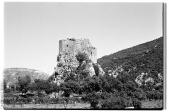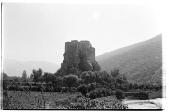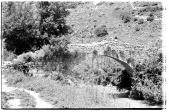
Mystery of Mousayliha Castle Solved Bruce Condè, 1955 and 1960 |
|

MsaylHa Castle in June 1964 © Børre Ludvigsen |
For many years it was not generally known that the small
castle of Mousayliha, near Batroun, was a 16th Century
foundation of the Ayyubid princes of Aleppo. Recent disclosure of this
fact by the Emir Izzat al-Ayyubi of Nakhle cleared up a long
period of doubt concerning the compact little fortress' origin and
also brought to light the fascinating story of the Sons of Saladin
in Lebanon, which will be described later in this article.
Mousayliha - the diminutive form of Maslaha, Arabic word for a fortified place - stands alone on top of a - detached rocky spur in the center of the Nahr el-Jaouze river valley beneath the mighty cliffs of Ras Shakka's southeastern face - the only one of Lebanon's castles to stand thus at the pinnacle of a sharp peak, like fairy tale castles in story books. 64 km. From Beirut
|

MsaylHa Castle in June 1964 © Børre Ludvigsen |
Only about 64 kilometers out of Beirut via Junie, Byblos and
Batroun; Mousayliha can be visited readily in a little over an
hour's driving time plus less than a half hour's walk.
Its location is inspiring, for the castle hill's southern slope is washed by the Jaouze River and its eastern one encased in apricot orchards and gardens, while a picturesque old Arab bridge beckons travellers from the south to approach its apparently inaccessible flanks. The perfectly-preserved outer walls of this miniature fortress, in buff sandstone similar in workmanship to the Crusader walls of Byblos and the Sayidet Naja Byzantine-Crusader chapel of that town, rise flush with the sheer rock of the peak so that one cannot go around them. Entry into the castle is by a steep stone staircase on the northwest side, which leads to a small, low arched doorway - the only one in the outer wall.
|

MsaylHa Castle in June 1964 © Børre Ludvigsen |
Perfect Preservation
Within, the triangular courtyard, rectangular keep, arched portals, vaulted ceilings, and arrow slits are in an almost perfect state of preservation, with only the battlements if there were ever any missing. Built like a ship to conform to the shape of the rocky outcropping, Mousayliha Castle's narrow a "prow" points southwest-ward toward Batroun with the more substantial rounded "poop deck", including the keep itself, oriented toward the Koura to the northeast. The view used to illustrate this article was taken from the west-southwest not far from the old arched bridge. Nineteenth centur travellers, attracted to the site by stories of its rugged isolation and picturesqueness, often sketched the castle from this southwestern angle asually incoporating the bridge too, for effect. For some strange reason the styled it "The Gothic Castle", although only refernces to the area's history indicated that it was near the site of an ancient Roman settlement guarding the narrow pass behind the Gibraltar-like Ras Shakka between Batroun and Tripoli.
|

MsaylHa Castle in June 1964 © Børre Ludvigsen |
Roman Remains
That the Roman north-south road passed through the valley there can be no doubt, and traces of a well-built Roman aqueduct, including a partly buried masonry arch, which may have carried both the waterway and a road over a small stream, not far to the southwest, can still be seen. The foot path of today, covered with Ioose stones, sometimes incorporates stonework of the aqueduct or fragments of the road As in the case of the Nahr Ibrahim's Roman aqueduct, this one seems to have been restored and used in medieval times possibly in connection with the castle's surrounding cultivated areas and the valley toward Batroun. Automobiles can proceed on the paved road leading northeast out of Batroun, and the rock and dirt road which continues it, up the valley for most of the distance to Mousayliha, parking in a narrow clearing near the spot where the route becomes a foot path. Hikers with appropriate footgear can negotiate the remainder of the journey in about 15 minutes altough those not accustomed to such jaunts, or equipped with less suitable shoes, should figure on 25 minutes or - a half-hour to reach the castle. Picnic Spot Water is available from the Jaouze river and there are many pleasant streamside picnic spots, shaded thick foliage, where lunch may be enjoyed in view of the castle. On the castle's upper terraces, if shade is not essential, picnic parties, cooled by a strong breeze, can enjoy good panorama views of the valley and sea, but there is no suitable place to eat inside the rooms or courtyard due to the castle's preemption by a populous colony of goats. In fact it might be called "Goat Castle" today for want of a more descriptive title. French archeologists, to whom Lebanon owes so much for the preservation of her monuments, were puzzled by, and almost hostile to, Mousayliha. To them it seemed to lack either classic or Crusader connatations and therefore to be outside the pale. While admiting that it might be of medieval construction, they inclined toward a Mamluk or even Turkish origin, some going so far as to say that it might be an 18th century modern fort. It was not until 1956 that the mystery was solvedt by researches carried out by Emir Izzat al-Ayyubi in connection with family historical investigations of the League of Ayyubid Princes. The young scion of the main line of the House of Saladin, then a law student in the Faculte de Droit of Beirut's Universite de St.-Joseph furnished most of the material on this subject which is reproduced below concerning Mousayliha, and in the subsequent four articles dealing with other historic Ayyubid structures scattered throughout the Koura.
Sons of Saladin in Lebanon Least-known of all Lebanese historical epics, in spite of its relatively recent date, is the saga of the Ayyubid princes of the Koura and Tripoli. It is somewhat of a mystery why so little survived in historical records concerning the romantic career of these direct male descen- dents of Saladin himself, as embattled feudal lords of the north during the 16th to 19th Centuries. Virtually unknown to the outside world, the Zahrite branch of the Ayyubid royal family, direct descendents of al-Malik az-Zahir al-Ghazi, King of Aleppo, Saladin's favorite son, has grown from a little band of four emirs and their sons and retainers, numbering only 30 souls, in 1517, to approximately 2,000 emirs, living principally in a half-dozen western Koura villages, today. Tent Encampment, 1517 From the original tent encampment of the emigre emirs from Aleppo on the Batroun plain in the early 16th Century the Ayyubid dwellings now number many hundred houses, a number of fortified towers or "great houses" and Lebanon's most picturesquely-situated castle. From the obscurity of the last century and the low-water-mark of World War I, when the impoverished princes lost much of their domain, there is emerging a new generation, which has formed a "League of Ayyubid Princes" for the cultural, social and economic revival of the "Ayyubid corner of Lebanon." In this, and the following four articles, will be presented in chronological and geographical order, the strange story of this 20th Century survival of 2 royal race of the Middle Ages. Battle of Marj Dabiq The story begins on the battlefield of Marj Dabiq, near Aleppo, in 1516, when the Mamluk Sultan of Egypt and Syria, Qansuh Ghawri. deserted by his discontented Syrian and Lebanese levies, was crushingly defeated by Ottoman Sultan Selim I. A contingent of surviving Ayyubid emirs of Aleppo, whose ancestors had lost their throne to the Mongols in 1260 and had been denied restoration by the Mamluks on the defeat of the Tartars, had supported Selim in the battle. The sultan desired to reward them, but under the circumstances could not return to them the kingdom of Aleppo, destined to become a key Turkish fortress and pashalik. Instead, the imperial Ottoman enfoeffed them in 1517, with the Lebanese coast from Batroun to Byblos and provided them with a firman to the governor of Batroun to that effect. In the firman, the Ayyubids were charged with preventing Crusader landings on the coast and with the protection of the Christian villagers from warlike mountain tribes under the powerful tribal chieftains of Hermel, who, in the declining years of Mamluk power, had begun to raid all the way to the coast, from which the Mamluks had driven them in the 14th Century. The governor of Batroun, a European renegade who had made common cause with the Turks, was determined not to respect the firman and to hold the coast for himself. The Four Emirs When the four emirs, Hasa, Musa, Ismail and Mohammed, presented themselves at his castle and requested the governor to turn over his power to them, he feigned compliance, but asked for a few days in which to arrange the transfer, lodging them, in the meanwhile, in a castle-like dwelling not far distant from his own. Suspecting a trick, after a week of procrastination, the princes sent one of their number, the Emir Mohammed, to demand immediate compliance with the imperial command. When, from the distance, the three brothers saw Prince Mohammed's headless body thrown from the governor's balcony, they rushed the fortress with their small band of retainers, aided by the townspeople, forced their way into the courtyard, recovered their brother's remains, and fought their way out again. No match for the renegade's strong garrison, they retreated to high ground overlooking the Batroun plain and Jaouze river from the north on top of the limestone plateau that extends to the great cap of Ras Shakka. The First Tower There, at Wuj al-Hajar, they built a fortified tower, a "great house~, whose remains are still called "Beit al-Omarah" (House of the Princes",) and a well-defended village for their retainers. Wuj al-Hajar, which still preserves fragments of the original Ayyubid "great hou se", in the dwelling of Munir and George Shamma near the church, including an arched portal, corbels, 16th Century tiny windows, a well, fireplace and chimney and several courtyard walls, has only a few corner stones remaining of its original Ayyubids tower of 1517, however. It is said that during the dispute between the Ayyubids of Ras an-Haash and the villagers of Hamate over possession of longabandoned Wuj al-Hajar lands, most vestiges of Ayyubid occupation including all remaining inscriptions, were buried hidden or destroyed and none of the property remains in Ayyubid hands today. Following the princes' retreat a messenger was dispatched post-haste to the Padishah and a series of almost daily encounters with the governor's Batroun. garrison troops took place in the vicinity of the river at Qubba. The wily governor, knowing his master's love of money, not only dispatched his own messenger, with counter-claims and allegations, but provided him with numerous bags of gold for the viziers and courtiers around the Sultan, with instructions to prevent the Ayyubid envoy from reaching the imperial diwan. The times being what they were, there was little the Ayyubids could do but organize the mountain portions of their fief the best they could, without attempting, for the time being, to control the coast. The Emir Ismail, after spending long months at the imperial court in person in an effort to gain redress, was finally given the separate fief of Qadmus, 70 miles to the north, and the embattled princes at Wuj al-Hajar were compensated with additional lands north of their stronghold, up to the gates of Tripoli. For Batroun-Tripoli Tripoli itself, instead of tiny Batroun, was given to them from time to time as a governorship, as was all or part of the Koura. Before abandoning their rights to the Byblos extension of the original fief, however, the emirs, bypassing Batroun, surveyed the "little mountain" of Jebail and decided that in view of the inability of the villagers to contribute significantly to its defense it was beyond Ayyubid power to effectively defend it. They thereupon deeded some of the crown lands in the vicinity to the Maronite church, to strengthen the Patriarch's hand, and recommended to Sultan Selim that the Turkoman emirs Assaf at Ghazir be charged with defense of the Byblos area. The Ayyubids thereupon withdrew to their new area of responsibility from Batroun to Tripoli. Noted for their tolerance and lack of fanaticism since the days of their chivalrous ancestor Saladin, under whom Byblos had passed into Ayyubid hands for ten years in the 12th Century, the 16th Century Zaherites entered into close and amicable relations with the Maronite patriarchate. Not only around Byblos, but also a few kilometers east of Batroun, overlooking the insurgent governor's fortress, the Ayyubids deeded additional lands to their Maronite allies, including the rich and extensive domain of the monastery of Abrine. Alliance With Patriarchs The World War I Patriarch, Monseigneur Hoyek, used to delight in bringing out records concerning the gift of Abrine, to show them to visiting Ayyubid princes at Bkerke, and to assure them of the continuance of their four-hundred-year-old friendship. Before the princes became strong enough to figure as governors of Tripoli and the Koura, they strengthened their position around Batroun by occupying the narrow pass to Tripoli at Mousaylihar some four or five kilometers up the river Jaouze. Here, on a spectacular sugar-loaf peak, was a small guard tower or fort. Some of its stones were Roman' others of typical marginally-dressed masonry of the medieval Mamluks. The Avyubid princes reconstructed it in the early 16th Century in its present form as a miniature castle, as, indeed, its Arabic name indicates, and held it until comparatively recent times. When they fell to fighting among themselves, in later years, over control of the vast family domains, Mousayliha's Ayyubids had to withstand many a siege from their neighbor on the cliffs above, the Emir Yusef al-Ayyubi of Wuj al-Hajar. The "Sparrow Prince" The prince of Mousayliha at that time was the Emir Qassub al-Ayyubi, all of whose 12 sons perished during the sieges. At the end, he escaped with his grandsons to the strong tower of Ras an- Haash and continued to elude his pursuers so successfully that he was dubbed "al-Amir ad-Duri", or, "The Sparrow Prince", and Mousayliha Castle came to be called, at that time, (and still is) among the Ayyubids, "Qalaat ad-Duri", or, "Sparrow Castle". Mousayliha has many Ayvubid names carved into its buff sandstone walls, as the only remaining evidence of its princely 16th Century origin today.
From See Lebanon, Bruce Condè, second edition, Harb Bijjani Press, Beirut, 1960
|

Created 970101